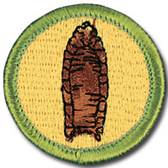Merit Badge Requirements
and Selection for Sanctuary on the Trail ™
1. Tell what archaeology is and explain how it differs from anthropology, geology, paleontology, treasure hunting, and history.
2. Describe each of the following steps of the archaeological process: site location, development of a research design, historical research, site excavation, artifact identification and examination, interpretation, preservation, and information sharing.
3. Describe at least two ways in which archaeologists determine the age of sites, structures, or artifacts. Explain what relative dating is.
4. Do TWO of the following:
b. Learn about three archaeological sites located within the United States.
c. Visit an archaeological site and learn about it.
For EACH site you research for options a, b, or c, point it out on a map and explain how it was discovered. Describe some of the information about the past that has been found at each site. Explain how the information gained from the study of these sites answers questions that archaeologists are asking and how the information may be important to modern people. Compare the relative ages of the sites you research
5. Choose ONE of the sites you picked for requirement 4 and give a short presentation about your findings to a Cub Scout pack, your Scout troop, your school class, or another group.
6. Do the following:
a. Explain why it is important to protect archaeological sites.
b. Explain what people should do if they think they have found an artifact.
c. Describe the ways in which you can be a protector of the past.
7. Do ONE of the following: STUDENT ON HIS OWN
a. Make a list of items you would include in a time capsule. Discuss with your merit badge counselor what archaeologists a thousand years from now might learn about you and the culture in which you live based on the contents of your capsule.
b. Make a list of the trash your family throws out during one week. Discuss with your counselor what archaeologists might learn about you and your family if they found your trash a thousand years from now.
8. Do ONE of the following:
a. Under the supervision of a qualified archaeologist, spend at least eight hours helping to excavate an archaeological site.
9. Under the supervision of a qualified archaeologist or instructor, do ONE of the following:
a. Help prepare an archaeological exhibit for display in a museum, visitor center, school, or other public area.
10. Do ONE of the following: (INDIAN LORE BADGE)
a. Research American Indians who live or once lived in your area. Find out about traditional lifeways, dwellings, clothing styles, arts and crafts, and methods of food gathering, preparation, and storage. Describe what you would expect to find at an archaeological site for these people.
11. Identify three career opportunities in archaeology. Pick one and explain how to prepare for such a career. Discuss with your counselor what education and training are required, and tell why this profession might interest you. STUDENT ON HIS OWN.
Call for appointment 540-554-8730.
2. Describe each of the following steps of the archaeological process: site location, development of a research design, historical research, site excavation, artifact identification and examination, interpretation, preservation, and information sharing.
3. Describe at least two ways in which archaeologists determine the age of sites, structures, or artifacts. Explain what relative dating is.
4. Do TWO of the following:
b. Learn about three archaeological sites located within the United States.
c. Visit an archaeological site and learn about it.
For EACH site you research for options a, b, or c, point it out on a map and explain how it was discovered. Describe some of the information about the past that has been found at each site. Explain how the information gained from the study of these sites answers questions that archaeologists are asking and how the information may be important to modern people. Compare the relative ages of the sites you research
5. Choose ONE of the sites you picked for requirement 4 and give a short presentation about your findings to a Cub Scout pack, your Scout troop, your school class, or another group.
6. Do the following:
a. Explain why it is important to protect archaeological sites.
b. Explain what people should do if they think they have found an artifact.
c. Describe the ways in which you can be a protector of the past.
7. Do ONE of the following: STUDENT ON HIS OWN
a. Make a list of items you would include in a time capsule. Discuss with your merit badge counselor what archaeologists a thousand years from now might learn about you and the culture in which you live based on the contents of your capsule.
b. Make a list of the trash your family throws out during one week. Discuss with your counselor what archaeologists might learn about you and your family if they found your trash a thousand years from now.
8. Do ONE of the following:
a. Under the supervision of a qualified archaeologist, spend at least eight hours helping to excavate an archaeological site.
9. Under the supervision of a qualified archaeologist or instructor, do ONE of the following:
a. Help prepare an archaeological exhibit for display in a museum, visitor center, school, or other public area.
10. Do ONE of the following: (INDIAN LORE BADGE)
a. Research American Indians who live or once lived in your area. Find out about traditional lifeways, dwellings, clothing styles, arts and crafts, and methods of food gathering, preparation, and storage. Describe what you would expect to find at an archaeological site for these people.
11. Identify three career opportunities in archaeology. Pick one and explain how to prepare for such a career. Discuss with your counselor what education and training are required, and tell why this profession might interest you. STUDENT ON HIS OWN.
Call for appointment 540-554-8730.


 RSS Feed
RSS Feed